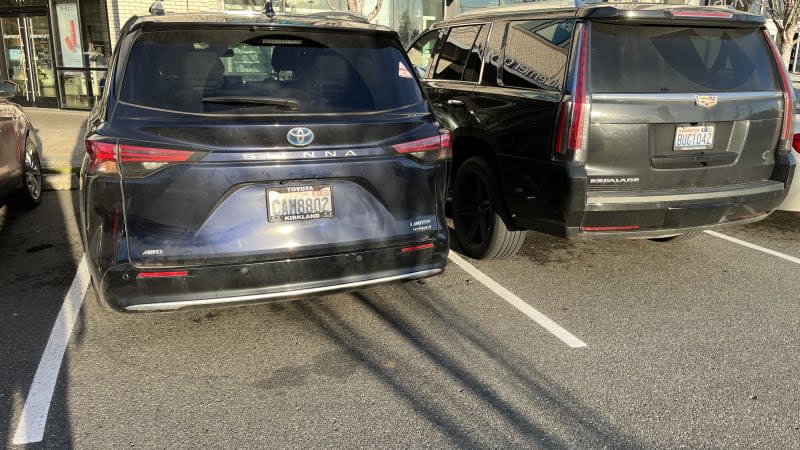Our vehicles got bigger, so why are we parking them in little spaces?


I was leaving the local butcher shop the other week when a bigger carnivore blocked my path: The driver of a Ford pickup was struggling to park his rig. It was the most-super of Super Duties — a crew cab long-box dually — so it took him a couple of minutes and several cuts of the wheel to ease the beast into a prime spot near the store entrance. He was holding up a lot of traffic.
That's a tight parking lot, with spaces 8-8½ feet wide. And the width of that dually at the hips? Also 8 feet. What was he thinking? Other than, “I’d rather do this than go find an easy spot on the back row and walk 50 yards.” Maybe he had a bum knee. Doesn't make his truck any smaller.
Granted, this was over the holidays, when parking lots get a little nuts. But why do drivers of big pickups or jumbo SUVs try to park among the normies?
We’ve all been in this situation: You return to your vehicle to discover somebody parked too close. You have to crawl in through the back hatch, or enter on the passenger side and clamber over the center console. Sometimes this is simply because of a bad parking job. Sometimes, a vehicle has been jammed into a space where it honestly doesn’t fit.

A Sienna and Escalade in 8½-foot spaces, about 18 inches apart. The minivan was there first; somehow the slender driver managed to slip out of the Escalade. But hey, she scored a spot close-in.
A typical parking space is 8 feet, or 96 inches. Sometimes 8½-9 feet. Perhaps not surprisingly, lots are not always striped very precisely. I've measured spots ranging from 7 to 10 feet wide in the same lot. Also, there might be regional differences — perhaps they're bigger in Texas. A sedan or small to medium SUV fits a typical spot just fine: A Honda Accord is 73 inches wide, a Toyota Corolla 70; CR-V and RAV4 are 73ish. If you’re dead-centered in an 8-foot space, that leaves about a foot of that space on each side. Assuming the same thing of the car parked next to you, you have 2 feet of room to exit. That's comfortable.
Those are the cars these spaces were made for.
But the trend toward bigger vehicles has made things uncomfortable. Full-size pickups are notoriously bigger than they were just a few years ago. They're around 80 inches, with Silverado at over 81. That's body width; some truck mirrors can span a full parking spot. Extreme examples are duallies, Cybertruck "Cyberbeast" at almost 87, Raptor at 87 inches, GMC Hummer at 87, Ram TRX at 88. Let's hope you rarely encounter those at a mall.
A Ford Maverick at under 73 inches, though, provides a welcome bit of cognitive dissonance: It’s a pickup, yet look at all this room! You can park it anywhere.
Midsize to large SUVs are 78-80 inches. Suburban/Tahoe/Escalade, 81. Jeep Grand Wagoneer is 83.6”, surpassing most pickups. Minivans are 80ish, but God bless sliding doors.
You’d think 6-8-10 inches wider than a sedan shouldn’t make much difference, but for, ahem ... some of us ... who are trying to squeeze out a door, it matters.
There’s a Golden Rule aspect to all this. Crowding your big truck into a too-small spot feels like the controversy over whether to recline your seat on a packed plane.

 Yahoo Autos
Yahoo Autos 
